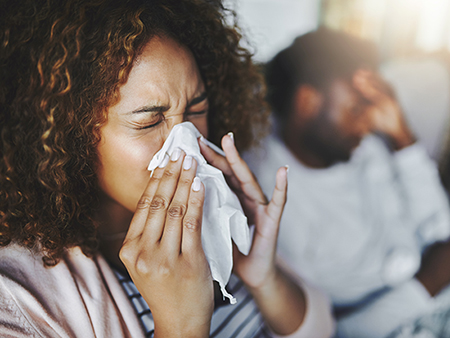Media contact: Savannah Koplon
 Illustration by Jody PotterDo I have a cold or the flu? It is a question that millions of people ask themselves throughout the fall and winter seasons. With the onset of colder weather, a mere cough or sneeze can send people to the doctor with this medical concern.
Illustration by Jody PotterDo I have a cold or the flu? It is a question that millions of people ask themselves throughout the fall and winter seasons. With the onset of colder weather, a mere cough or sneeze can send people to the doctor with this medical concern.
However, there are differences between a cold and the flu that are easy to spot and will lead to easier treatment and prevention.
Molly Fleece, M.D., assistant professor in the Division of Infectious Diseases at the University of Alabama at Birmingham, is optimistic that knowing these differences can lead to staying healthy this flu season.
What symptom means what?
While both the cold and flu are caused by viruses and lead to a stuffy nose, coughing and a sore throat, how to know the difference between cold and flu symptoms, many of which overlap, can make a world of difference when it comes to figuring out the type of infection you may have.
A cold happens gradually and is felt mainly in the head and the nose, with more mild symptoms and fatigue. While you may feel crummy, if you do not have a fever, you can still generally continue to go about your day.
However, if you have the flu, symptoms are much more severe than a cold and have a quick onset. Muscle aches and aches throughout the body are symptoms unique to the flu, with additional flu symptoms — including fever, exhaustion and a loss of appetite — usually lasting about a week.
“Knowing the difference in symptoms could help you determine the best route for treatment,” Fleece said. “Both types of illness will take rest and fluids to recover. Depending on the type of infection, a physician may be able to prescribe an antiviral drug to help speed up the recovery process by shortening the amount of time that a person is sick and preventing the serious complications that can come with the flu.”
How to prevent
|
Vaccines can reduce the risk of illness between 40 to 60 percent. For more information about flu prevention, visit uab.edu/flu. |
Cho Do-Yeon, M.D., M.S., associate professor in the Department of Otolaryngology, says the best way to prevent the flu is to get the vaccine. “Other than some soreness around the injection site, there are no notable side effects linked to the flu vaccine,” Cho said.
According to the Centers for Disease Control, flu vaccines can reduce the risk of the flu illness between 40 and 60 percent throughout the overall population. The recommended time for people to receive the flu shot begins in October but is still effective as late as January. Even getting it in February can still protect you through the rest of the year and continue to build your immune system in preparation for the next season.
In addition to the flu shot, the best ways to prevent the spread of the flu include:
- Washing hands with soap and water as often as possible
- Carrying hand sanitizer as an extra precaution
- Avoiding contact with those who have been exposed to the flu or experienced symptoms
- Covering the mouth to avoid the spread of germs when sneezing or coughing
- Staying home when sick
 These are also ways to avoid catching a cold. In addition to following all of the steps above to limit the spread of germs, people who sleep the recommended eight to 10 hours a night strengthen their body’s response to fighting off viruses.
These are also ways to avoid catching a cold. In addition to following all of the steps above to limit the spread of germs, people who sleep the recommended eight to 10 hours a night strengthen their body’s response to fighting off viruses.
Cho reminds people that there is no cure medication for the cold. “If you catch a cold, antibiotics shouldn’t be used unless there’s a bacterial infection. Treatment is directed towards relieving signs and symptoms.”
For those who do catch the flu, Fleece cautions to not panic or visit the emergency room; the exception would be for immunocompromised patients such as the elderly or those with weakened immune systems from cancer treatment, etc. If feverish, Cho says that people should stay home for at least 24 hours to ensure that the fever is gone.
Experts say that most healthy people with the flu should avoid the emergency room to minimize the risk of catching another illness while waiting for treatment. Many vulnerable populations who are in emergency department waiting rooms increase their risk of catching the flu when others expose them to the disease. However, those with severe symptoms such as vomiting, increasing shortness of breath or a high heart rate should visit the emergency room.
If none of those complications have occurred, the best way to treat the flu is with plenty of rest and fluids. Find more information and resources for staying healthy this flu season here.